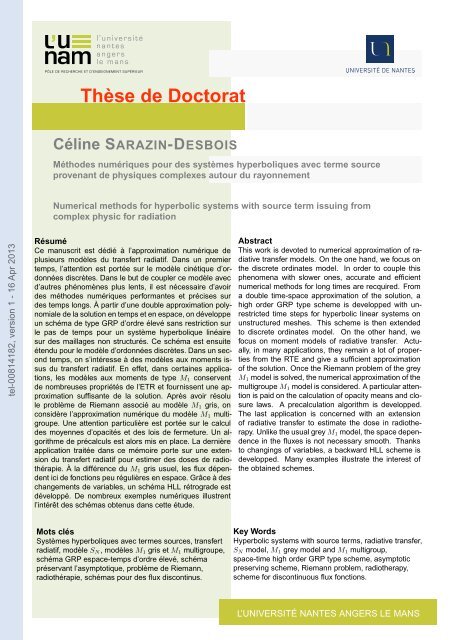Méthodes numériques pour des systèmes hyperboliques avec terme ...
Méthodes numériques pour des systèmes hyperboliques avec terme ...
Méthodes numériques pour des systèmes hyperboliques avec terme ...
Create successful ePaper yourself
Turn your PDF publications into a flip-book with our unique Google optimized e-Paper software.
Thèse de Doctorat<br />
Céline SARAZIN-DESBOIS<br />
<strong>Métho<strong>des</strong></strong> <strong>numériques</strong> <strong>pour</strong> <strong>des</strong> <strong>systèmes</strong> <strong>hyperboliques</strong> <strong>avec</strong> <strong>terme</strong> source<br />
provenant de physiques complexes autour du rayonnement<br />
Numerical methods for hyperbolic systems with source term issuing from<br />
complex physic for radiation<br />
tel-00814182, version 1 - 16 Apr 2013<br />
Résumé<br />
Ce manuscrit est dédié à l’approximation numérique de<br />
plusieurs modèles du transfert radiatif. Dans un premier<br />
temps, l’attention est portée sur le modèle cinétique d’ordonnées<br />
discrètes. Dans le but de coupler ce modèle <strong>avec</strong><br />
d’autres phénomènes plus lents, il est nécessaire d’avoir<br />
<strong>des</strong> métho<strong>des</strong> <strong>numériques</strong> performantes et précises sur<br />
<strong>des</strong> temps longs. À partir d’une double approximation polynomiale<br />
de la solution en temps et en espace, on développe<br />
un schéma de type GRP d’ordre élevé sans restriction sur<br />
le pas de temps <strong>pour</strong> un système hyperbolique linéaire<br />
sur <strong>des</strong> maillages non structurés. Ce schéma est ensuite<br />
étendu <strong>pour</strong> le modèle d’ordonnées discrètes. Dans un second<br />
temps, on s’intéresse à <strong>des</strong> modèles aux moments issus<br />
du transfert radiatif. En effet, dans certaines applications,<br />
les modèles aux moments de type M 1 conservent<br />
de nombreuses propriétés de l’ETR et fournissent une approximation<br />
suffisante de la solution. Après avoir résolu<br />
le problème de Riemann associé au modèle M 1 gris, on<br />
considère l’approximation numérique du modèle M 1 multigroupe.<br />
Une attention particulière est portée sur le calcul<br />
<strong>des</strong> moyennes d’opacités et <strong>des</strong> lois de fermeture. Un algorithme<br />
de précalculs est alors mis en place. La dernière<br />
application traitée dans ce mémoire porte sur une extension<br />
du transfert radiatif <strong>pour</strong> estimer <strong>des</strong> doses de radiothérapie.<br />
À la différence du M 1 gris usuel, les flux dépendent<br />
ici de fonctions peu régulières en espace. Grâce à <strong>des</strong><br />
changements de variables, un schéma HLL rétrograde est<br />
développé. De nombreux exemples <strong>numériques</strong> illustrent<br />
l’intérêt <strong>des</strong> schémas obtenus dans cette étude.<br />
Abstract<br />
This work is devoted to numerical approximation of radiative<br />
transfer models. On the one hand, we focus on<br />
the discrete ordinates model. In order to couple this<br />
phenomena with slower ones, accurate and efficient<br />
numerical methods for long times are recquired. From<br />
a double time-space approximation of the solution, a<br />
high order GRP type scheme is developped with unrestricted<br />
time steps for hyperbolic linear systems on<br />
unstructured meshes. This scheme is then extended<br />
to discrete ordinates model. On the other hand, we<br />
focus on moment models of radiative transfer. Actually,<br />
in many applications, they remain a lot of properties<br />
from the RTE and give a sufficient approximation<br />
of the solution. Once the Riemann problem of the grey<br />
M 1 model is solved, the numerical approximation of the<br />
multigroupeM 1 model is considered. A particular attention<br />
is paid on the calculation of opacity means and closure<br />
laws. A precalculation algorithm is developped.<br />
The last application is concerned with an extension<br />
of radiative transfer to estimate the dose in radiotherapy.<br />
Unlike the usual greyM 1 model, the space dependence<br />
in the fluxes is not necessary smooth. Thanks<br />
to changings of variables, a backward HLL scheme is<br />
developped. Many examples illustrate the interest of<br />
the obtained schemes.<br />
Mots clés<br />
Systèmes <strong>hyperboliques</strong> <strong>avec</strong> <strong>terme</strong>s sources, transfert<br />
radiatif, modèle S N , modèles M 1 gris et M 1 multigroupe,<br />
schéma GRP espace-temps d’ordre élevé, schéma<br />
préservant l’asymptotique, problème de Riemann,<br />
radiothérapie, schémas <strong>pour</strong> <strong>des</strong> flux discontinus.<br />
Key Words<br />
Hyperbolic systems with source terms, radiative transfer,<br />
S N model, M 1 grey model and M 1 multigroup,<br />
space-time high order GRP type scheme, asymptotic<br />
preserving scheme, Riemann problem, radiotherapy,<br />
scheme for discontinuous flux fonctions.<br />
L’UNIVERSITÉ NANTES ANGERS LE MANS
















